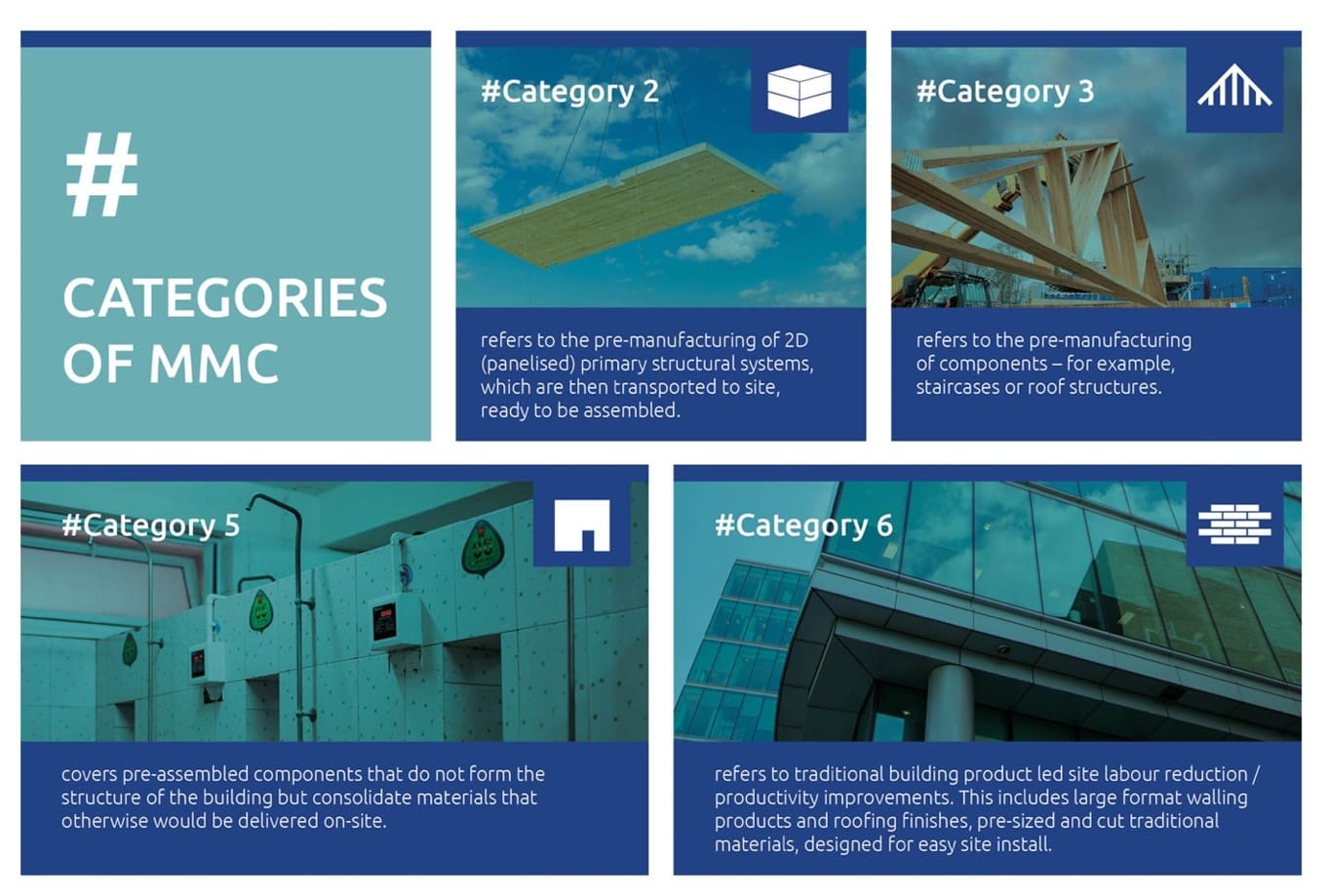Ross Baxter, managing director of Saint-Gobain Off-Site Solutions, explains how Categories two, three, five, and six as defined by the UK Government’s cross-industry working group for Modern Methods of Construction (MMC), can be utilised as part of the wider solution to solve the UK’s housing crisis
In the UK, the demand for affordable housing remains high, and the supply of new homes remains limited. Simply put, more high-quality homes need to be built.
The reasons behind constrained supply are complex, but one area that need not be is the use of different construction methods designed to improve build consistency and delivery speed.
The purpose of Saint-Gobain is to “Make the World a Better Home”, and in the Off-Site Solutions division, we aim to realise this purpose by supporting the delivery of sustainable housing across the UK.
Embracing MMC will address the UK’s housing crisis
In 2022, it was reported that Homes England were falling short of their affordable homes target. By embracing MMC, we believe that Homes England can move closer to reaching their targets and address the UK’s housing crisis in a consistent and sustainable manner.
Year on year, the UK Government reports on the rising numbers of households awaiting affordable social housing. In 2022, it was reported that over 1.2m households were on the waiting list across all regions of the UK, an increase of 5% since 2020.
And with the Department for Levelling Up, Housing and Communities reporting that in 2021/22, only 7,500 homes were built for social rent, it is clear more needs to be done to support the delivery of these desperately needed homes.
It’s clear that a broad strategy, including repair and improvement of existing housing stock and new build, is required to meet the challenge.
In an industry challenged by rising costs, inflation in materials and energy and a widening skills gap, it’s equally clear that the delivery of these homes will require innovative approaches to both design and on-site.
There is a reluctance across the industry to adopt MMC technologies
I believe it was with this in mind that under the current Affordable Homes Programme by Homes England, 25% of all homes were targeted to be built using MMC by 2026.
However, a report by Savills, one of the UK’s biggest estate agents, showed that the number was closer to 6-10%.
There perhaps remains a reluctance to adopt MMC technologies, which may be due to lack of confidence in their application or a lack of familiarity with the range of solutions now available.
The term MMC is in some ways itself not overly helpful, as some of the systems that fall under it have been in use for decades, providing us with many successful examples and case studies to learn from.
The umbrella term MMC includes many building techniques, systems, and technologies. The UK Government’s MMC framework splits this spectrum of innovative construction techniques into seven categories, covering all types of off-site pre-manufacturing, new site-based materials and techniques, and process innovation.

For example, Saint-Gobain Off-Site Solutions delivers products, systems, and solutions which fall under Category 2, Category 3, Category 5, and Category 6.
When considering the specific needs of a particular project, with its specific site constraints and demand in location and density, applying the categories of the MMC framework can give a useful guide to selecting the best routes for delivery.
Not all sites are suitable for all methods, and we as an industry have to acknowledge that different systems, materials and processes will be needed to deliver the volume of housing that is required. It’s not about a one-size-fits-all approach.
Why should MMC be embraced?
Using MMC in the built environment offers many well-documented benefits.
Speed of build
The most well-known and proven benefit is that utilising MMC can significantly speed up build time on site.
To put this into perspective, Saint-Gobain Off-Site Solutions’ brand Roofspace Solutions can deliver the shell of a home up to 40% faster than a traditionally built home, and our timber frame and steel panel systems from Intrastack, Scotframe or Pasquill can deliver a full building structure in a few days.
By adopting MMC, social housing providers and housing developers can hand over the keys to healthier homes much faster than with traditional building methods.
There are several factors which can contribute to the speed of the build when using an off-site solution.
Once the design has been agreed between the client and the manufacturer, the manufacturing process commences concurrent with the site preparations.
Traditionally, foundational structures are laid on-site and must be completed before other work can take place.
With MMC, the key benefit is that whilst foundations are being laid, MMC factories will simultaneously be manufacturing panels ready for transportation to the development, ready to begin assembling on site as soon as foundations are ready. This offers a notable time saving for clients by efficiently allocating time and resources.
Panels are designed to slot together and are installed using cranes, which reduces the reliance on on-site labour and enables the structure to be erected quickly and efficiently, ready for follow-on trades to begin their fit-out.
Outside of fully off-site systems, the use of components such as roof trusses or panelised roofs, or Cat 6 systems, such as large format masonry systems, allow developers to blend traditional and MMC solutions to further increase delivery speed.
Reliable and higher quality
In addition to speed, dwellings built using MMC are designed to be constructed to a high degree of quality, with the inhabitant’s wellbeing, in mind.
There is nothing to say that a traditionally built building cannot attain an outstanding level of finish. However, within factory environments, there is greater control of the processes, making quality inspection simpler and results more consistent.
With a well-delivered MMC solution, design issues should be cleared early in the process, ensuring that the systems are delivered to the site exactly to specification, with any defects addressed before they leave the factory.
This can minimise issues on site, both during the erection of the building and also in its performance through its in-use life.
Addressing the skills shortage
It is no secret that there is a growing shortage of skilled construction labour within the UK. It is estimated that one-third of the current workforce is over 50 and set to retire within the next decade.
Add to this the fact that too few young people are interested in working in construction or related trades, therefore there is a risk many skilled roles will be left vacant with no one to fill them as the current workforce begins to retire.
Using MMC can help to bridge this skills gap, relying less on traditional on-site skilled labour, and more on trained operators working in factories with specialist machinery.
These operators can learn on the job in a safe and controlled factory environment and upskill with time, providing a promising career to those who wish to pursue it.
Cost certainty
Cost is a significant factor of any new development, and poorly managed costs can spiral due to changes on site in design and scope, variability in materials, labour and equipment.
The use of MMC is not the only way this can be improved, but an approach utilising well-thought-out and optimised designs can certainly help to control costs, bringing certainty and reducing on-site programme time.
Utilising MMC can provide greater cost certainty across the whole project, as factors that would usually delay a project and increase costs, such as bad weather, have a lower impact. With housing associations always working to tight budgets, cost certainty is critical and adopting an MMC approach can help to keep costs within the lines.
Energy efficiency
In times when homeowners are feeling the pinch with their energy bills, building an efficiently insulated home is crucial.
As we can see from recent uplifts to Part L and Part F of the building regulations and the developing Future Homes Standard, the improvement of building fabric performance, and the reduction of any variance between as-designed and as-built performance will be a key challenge to the industry as we transition towards a lower carbon economy.
It’s something Saint-Gobain are investing huge time into researching – the latest example being the award-winning eHome2 project at Salford University.
MMC solutions, when well applied and intelligently designed, enable higher-performing structures to be delivered with relative ease.
High-performing insulation can be built into wall panels, ensuring there are no voids creating cold areas in walls, and with factory efficiency and inspection, there is no excuse for a building not performing as it should on-site. This, in turn, will reduce the energy used over the lifetime of a home and help to reduce energy bills when it’s needed the most.
Better for the environment
With the world turning to more sustainable options wherever possible, and rightly so, MMC plays a part in reducing emissions within the built environment.
Although the building itself plays a key part, fewer deliveries to the site means fewer vehicles on the road, while less machinery required on-site, less dust, and less noise all limit the impact on the environment and the surrounding communities.
What happens next?
With housing in such high demand, we encourage those responsible for their delivery to continue to look towards alternative building methods to increase the supply quickly and in volume, without compromising on quality and sustainability.
MMC is often quoted as being the future of construction, but the real benefit comes from embracing it today. Beginning to implement these methods now will allow the UK to scale up housing delivery faster, delivering high-quality, much-needed homes to those who require them the most.
To find out more about how off-site solutions can help with your next project, please find out more at offsite.co.uk or get in touch with our expert team.

















